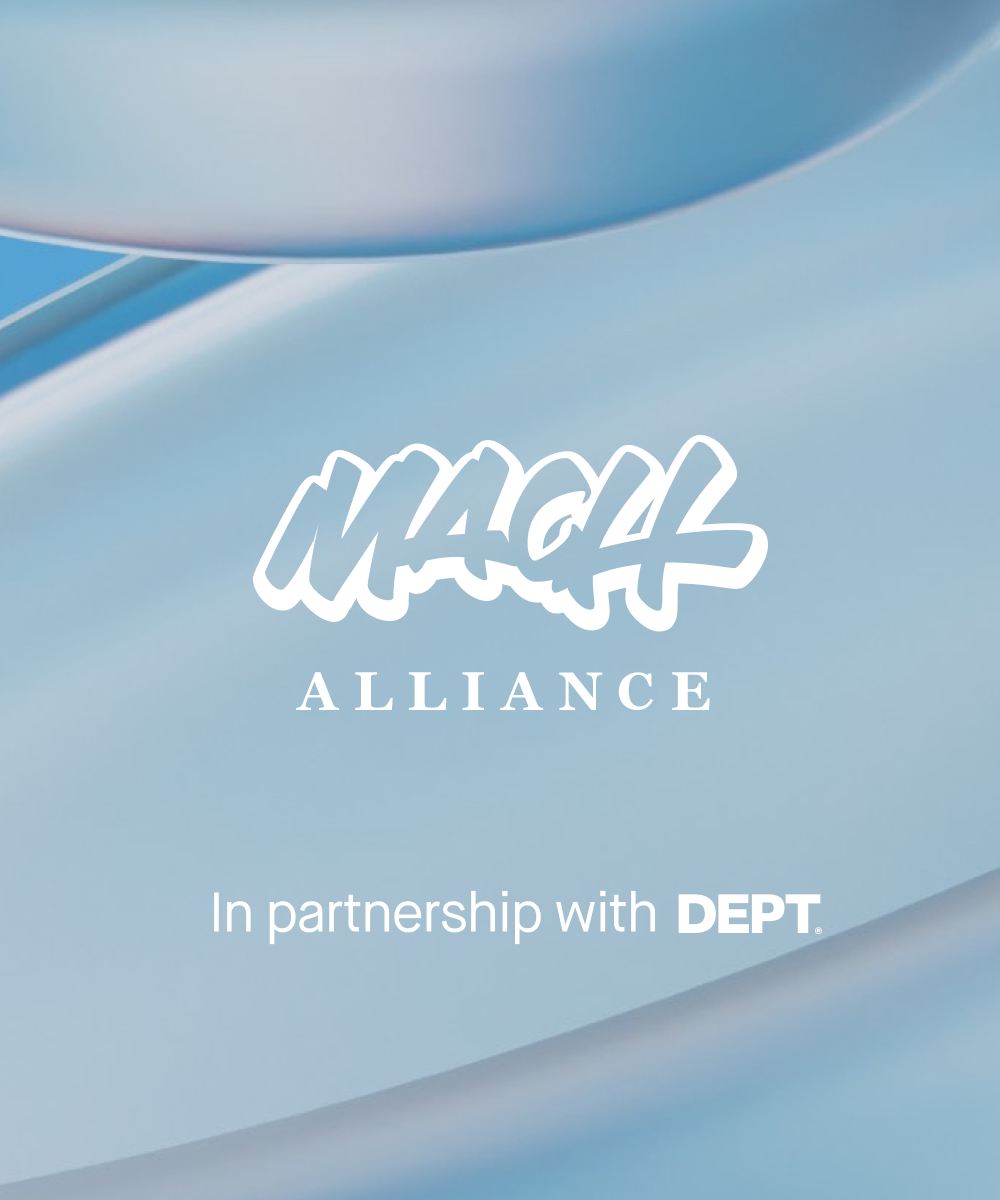When investigating headless content management systems and whether it’s the right solution for your business, you will undoubtedly encounter various pros and cons. You can simplify this process by aligning the advantages and drawbacks of a headless CMS by comparing it with a classic CMS, making the decision process a whole lot easier.
What is a headless CMS?
Nothing to lose your head over, to be perfectly honest – yes, pun intended. When you boil a headless CMS down to its essentials, you will get a database with a simple user interface. It serves your data via an API to any client (website, mobile app etc.) that may depend on it.
Similar to database tables, a ‘content model’ is a core concept of any headless CMS that, when defined, gives structure to the data. Content model examples are concepts such as ‘Product’, Contact person details’, ‘Content page’ etc.
Content models contain fields that the end-user can fill in, producing a data object which is essentially your content. Data objects are an equivalent to a table row. Most self-respecting headless CMS systems will allow you to reference other data objects in order to form advanced structure and dependencies within the data itself. A foreign key, if you will.
Now you may be asking yourself “if a headless CMS is nothing more than a database, what use do I have for it? Why not simply have a database?”
Well, you could, but you would be missing out on some key advantages that a good headless CMS will provide you and your team.
What are the advantages of a headless CMS?
When working with a headless CMS, you will benefit from easier setup, simplified maintenance and will be working with a well-tested set of tools that make content creation and validation much simpler. A headless CMS will make your data available to any number of clients across platforms and programming languages, thus allowing you to create platforms instead of simple websites. To top it off, you will also have access to built-in support for data versioning, meaning that you can correct any mistakes without dealing with database backups.
- Timesaving tool: A headless CMS is another tool in the software engineer’s tool-belt. It will save you a lot of time when building a system either for yourself or your clients. Moreover, you save even more time if the system you are building is evolving and changing, thereby requiring you to alter your data types.
The very fact that you can open the UI and create new and edit existing data types spares you a lot of effort. No need to mess around with SQL and database upgrade scripts. It is all handled by the CMS. - Validation for properties: Contrarily to a regular database, with a headless CMS, you’ll benefit by being able to define powerful validation properties. By defining the required fields as well as the string field format (email, phone, regex, etc.), managing data quality is effortless. Moreover, a headless CMS provides you with the choice of how to display input to the end-user. The goal may be to display a list of strings as a single text box that produces ‘tags’ on every press of the ‘enter’ button. It could be multiple text boxes, one below the other for easy editing; limiting the scope of available dates on a calendar; the number of decimal points for a number; type of file you want to allow your end-users to upload, or the maximum dimensions of the image.
You get the point, a headless CMS will put all these tools at your disposal with only several clicks, leaving you to spend your time writing meaningful code. - Data history and backup: Once your end-users start using the CMS, you may run into a situation where critical data is deleted or overwritten, and you need to get it back. A headless CMS will generally allow for a smooth data object audit. See who destroyed the data so they can get a slap on the wrists while you restore any lost values in just a few clicks. No need to fumble around with days old database backups that will restore your data to an ancient version only to restore one critical piece of information.
- Stability: An established, ‘battle-hardened’ headless CMS will generally be well tested, stable and bug-free. It will save you the stress of writing a custom UI for data input, much like a classic CMS will.
- Cloud: Headless content management systems are cloud-based, meaning that it is a server which is available to you and your end-users 24 hours a day/7 days a week. The only tool that you will need to access it and edit the data is a simple web browser. No specialised tools required for you or the end users.
Headless vs. classic CMS
So far, a headless CMS seems to have many advantages over a simple database, but what sets it apart from a classic CMS? Seeing how a classic CMS will usually be able to boast the same features, which of the two is better? Which one should you use? The answer depends on what you are trying to build.
If you’re building a website, a classic CMS is a perfect choice as it will allow your internal users to access it directly and preview any changes while editing the data. If you are dealing with a classic open-source CMS, you will perhaps be able to alter it and install custom plugins to allow more functionality.
But what happens when you want to build a complex platform? Imagine a project where you need to build several websites and mobile apps for both Android and Apple ecosystems which, in turn, share the data with the website. Hypothetically, the system may involve additional services that run on Linux and Windows servers. And what if you want to support third-party developers?
In this over-exaggerated scenario, a classic CMS fails to deliver, given that you would need to write your own API around it to satisfy all those apps and services. You will need to manage caching, security and data consistency, for example.
A headless CMS will provide these features to you ‘out of the box’ as the API is the primary way for you to interact with a client app, website or any other client. It allows you to specify security tokens that can only access a specific subset of data. By generating unique security tokens for each data consumer, you can create a safe way for any client apps to read and write the data that they have access to. Multiplatform compatibility is not a concern since you will generally be dealing with JSON, which every modern programming language can process.
Webhooks
Another powerful feature of a headless CMS is the ability to define and fire off webhooks. These are simple event-driven systems that send HTTP requests that you define to any URL of your choosing. For example, this allows you to notify all of your websites that a product description in the CMS has changed, and that the cache should be cleared to retrieve a fresh copy of the data.
What are the downsides of a headless CMS?
While boasting many advantages, a headless CMS is not perfect. It will put some obstacles in your way and make certain scenarios complicated to deal with. For example, difficulty in testing new features without affecting live environments, offline work for your client systems, and the fact that your data exists on a server which you don’t control.
- Testing difficulties: testing your code for various environments (test, integration, production), may not be as straightforward on a headless CMS, because many of them do not support this feature. More often than not, you will be dealing with a single environment and one set of data, which causes issues when developing new features or changing existing ones in a way that forces you to adapt the data models.
- Ideally, one would do so on an isolated environment so as not to affect the existing data. Some headless systems include tools for duplicating your data and allowing you to access it separately from the original, which solves half the problems related to this drawback. However, when making changes to content models or the data itself and the time comes to release the new feature, developers often face problems in propagating those changes back to the original environment without damaging it or causing data corruption. You can expect manual data model adjustments in some headless CMS systems.
- Always online problems: despite the benefits of a constant online presence, it can be a problem when your client software loses access to the internet. Unless you put in a lot of effort to cache your data and properly synchronise any changes with the headless CMS, it may cause you a lot of headaches when the various mobile apps, services, and applications come online and start injecting old data into the existing system. You may get messed up IDs, duplicate data, out of order data, etc.
- Data behind a paywall: in the case of paid solutions, you will be required to shell out a monthly subscription. If you don’t pay your subscription, your data may no longer be made available to you. It’s as simple as that. You may be spared this downside when using a free product, but free products often have a stigma of being of lower quality due to low incentives for developers to maintain and update them.
- In most cases, you will probably be able to retrieve your data via support staff, but unless you pay your subscription, the API access is going to be blocked, thus rendering your clients completely cut off from the data.
‘Too long, didn’t read’ summary
A headless CMS is an advanced database with a simple interface. One should view it as a tool that will save you a lot of time and effort because it will usually come with powerful features for validating data, ensuring its safety and versioning. It will generally be stable and well tested. Another major benefit is that your data will be available to you via an API 24 hours a day/7 days a week. A headless CMS’s most important feature is that it bridges the gap between platforms and programming languages, as it will generally serve your data in the form of XML or JSON.
A common problem that comes with using a headless CMS is the lack of support for data separation for multiple environments (test, acceptation, integration, production, etc.). It will often be quite a bit of work to alter production without a lot of careful, manual editing of content types. Being always online is good when it works as intended, but if your clients lose connection to the headless CMS API, you may run into issues with data synchronisation. Finally, if you use a licenced headless CMS, your data will be behind a paywall.
More Insights?
View all InsightsQuestions?
Global SVP Technology & Engineering
Jonathan Whiteside

Every business has a different growth trajectory. Technology that doesn’t scale in the right directions can become a blocker to future growth, and is one of the reasons why a headless approach is increasing in popularity; as businesses can gain more flexibility and discover greater possibilities for customisation and personalisation.
There are several reasons for the shift towards headless architecture, but speed and scalability most often drive the decision to implement a headless technology stack.
Unleashing the power of microservices
By combining best-of-breed platforms, with niche functionality specialised for commerce, search, payment or data management and so on, businesses can completely customise their front-end to suit their unique needs, as opposed to working with a predetermined tech structure provided by an all-encompassing solution.
When these platforms are integrated with a headless CMS, brands benefit from a centralised content hub. This makes editing much easier: a change in one place is seamlessly deployed everywhere the content is located. Unification improves brand consistency and compliance, and gives marketers more freedom to launch and optimise campaigns in real-time. As a certified Contentful partner, DEPT® utilises the future-ready cloud-native solution to help organisations accelerate growth.
Scaling omnichannel content management
Content consumption is evolving to be more fluid with audiences moving from one device and platform to the next, looking to be immersed and entertained without any interruptions. For brands to keep up with the demand for digital experiences, they need to move fast and avoid bottlenecks of multi CMS silos that can form in different markets or sub-brands when systems’ aren’t connected.
Creating an internal single source of truth through the headless CMS connects departments and streamlines delivery. Push-button deployment moves content into production and radically increases the velocity of fresh content on a global, enterprise scale. Brands can better align content across channels, repurpose existing content to improve its impact and ensure the right message reaches each target audience. The possibilities are limitless. Contentful’s open APIs work seamlessly with other tools or microservices and equip marketers to deliver a truly omnichannel strategy.
The solution is not only favoured by businesses and their marketing teams, but also by digital builders, according to Depsters that were recently Contentful certified.
Advancing commerce and beyond
Headless commerce allows businesses to adopt new touchpoints without needing to rework everything else. Contentful’s building block approach integrates with emerging technologies like AI-powered voice assistants, wearables, and smart applications, while still leveraging traditional channels like web, social media and SMS.
“A modern stack of integrated solutions is required for brands to keep pace with changing commerce by delivering relevant content when, where and how consumers expect it. Contentful runs on the world’s leading commerce platforms, including CommerceTools and Amazon, advancing businesses’ application of these platforms by supporting features such as AWS Auto Scaling,” said Daniel Proctor, Senior Developer at DEPT®. “Wherever Contentful is integrated, its content delivery API (CDA) enhances performance with fast, flexible, caching that can be tailored to individual customer needs and locations. As a result, Contentful effectively manages large spikes in traffic, maintaining a strong cache hit ratio (CHR) and seamless scalability as businesses grow globally.”
DEPT®’s Solutions Architect, Andy Whitehead adds: “The Contentful Marketplace has so many applications available to extend its capabilities through third-party services. You can also write your own custom extensions to work for any different scenario. Contentful’s in-depth documentation and software development kits (SDKs) simplify custom work and make collaboration between developers easier, whether that’s joining a client’s in-house team or getting caught up to speed when optimising the platform down the line with new functionality.”
Content delivery plays a key role in all industries, not just e-commerce. Moving quickly, without being held back by development constraints of some more traditional CMS platforms, is critical for conversion rates and is a growing requirement when building a stable solution at scale. This applies in a B2B context as well. More than 80% of business purchasers surveyed by Salesforce want consumer-level customer experience, and more than two-thirds of respondents say that they have switched vendors to get it. There’s a huge opportunity for B2B business owners to tap into through better technology and personalisation, considering 77% of B2B buyers surveyed by Gartner described their most recent purchase as very complex or difficult.
Reducing development time
Contentful’s new take on content as a service (CaaS – a sub-group of SaaS) simplifies the set-up and deployment processes, allowing developers to get started faster and spin up solutions that reduce businesses’ reliance on technical teams.
“Contentful is programming language agnostic, meaning teams can work in their preferred language and businesses moving into the model can keep content as it is without having to migrate data, for example, as they move from an HTML site to a React single-page application (SPA),” commented Andy Blyth, Technical Architect at DEPT®.
He further adds, “Contentful is constantly adding new features and functionality, allowing businesses using the service to evolve with the latest technology. Tagging has recently been released, grouping pages or objectives by characteristics or usage, which creates content classifications and eases the process of organising various components and multimedia files for editors.”

“Contentful is constantly adding new features and functionality, allowing businesses using the service to evolve with the latest technology.”
Andy Blyth, Technical Architect, DEPT®
Publishing content at scale
Chris Eccles, Technical Architect at DEPT® describes a Contentful project currently in development: “We’re working with an online learning provider that also performs English language tests for university, professional or migration applications. Contentful is populating the platform and we’re using its new web app, Compose. Setting up structured and reproducible fields is straightforward and the content management interface is the most intuitive I’ve ever seen. It uses a page-based model to streamline the process of adding and publishing content at scale, giving editors clear and flexible templates to quickly deliver uniform digital experiences, and in this case, across all of its programmes and courses.”
Contentful’s uncluttered interface experience helps reduce the level of intimidation and complexity for the user with simple logic and drag-and-drop features. Its ability to integrate with more no-code and low-code (NC/LC) tools means people from cross-functional teams have the ability to offset business demands for development, automate processes and accelerate digital transformation.

“The content management interface is the most intuitive I’ve ever seen.”
Chris Eccles, Technical Architect, DEPT®
Solutions for future business goals
Making the move to microservices via integrated headless solutions like Contentful creates the foundation for growth, however that may relate to your business. It’s easy to look at a new piece of technology and relate to case studies that highlight how it helped other companies increase volumes of sales, but growth is more dynamic and often involves changing workflows, governance, supporting technology and even security needs.
Overconfidence in a system’s ability to scale, without taking into account growing pains and unforeseen complexities can block innovation and lead to technical depth. In today’s ever-changing landscape, it’s difficult to predict what the future will hold, therefore, creating a solution built for change will underpin any avenue.
Putting Contentful into practice
Over the years, DEPT® has supported various companies with the successful application of Contentful. We collaborated with global shipping container supplier CARU Containers on a digital transformation project that involved building a new B2B online store fuelled by Contentful and Salesforce.
The new website was launched across ten countries as part of the refreshed CARU brand. Content pages were created to tell the story of the company, the employees, and each product. Additionally, there was content for social sharing and digital advertising: whitepapers, listicles, infographics and interviews. Content was displayed dynamically and adaptive to the language and country of each visitor, allowing one site to match up with an international audience. This content suite gave CARU positioning on LinkedIn, Google Ads, Microsoft Ads and the Google Display network. During the six month period of analysis and improvement, conversion grew by 400%, a sizable improvement that any company would be happy to see.
Content was also a key ingredient in transforming the 2021 Eurovision Village into a 3D Virtual World. The Eurovision Song Contest was streamed live, alongside additional DJ sets and performances and fresh content was served up daily throughout the nine-day festival. DEPT® integrated Contentful as the CMS, enabling a partnership agency to interact with guests and communicate updates in real-time, such as changes to the line-up.
We’ve also collaborated on projects for leading seafood supplier, Sykes Seafood; B2B travel company, Cartrawler; the Global Psoriasis Atlas; student discount platform, Totum; and the world’s number one chemical distributor, DigiB.
To stay ahead of the competition, agility and adaptability is a must. If your company has already implemented a headless stack but isn’t maximising its capabilities to their full potential, or is still weighing up the options, we’re here to help.
Contact us to discuss your digital landscape and how Contentful may be able to fit into it, perhaps by enriching your product information management (PIM) solution with marketing content or translating content in a mobile app.
More Insights?
View all InsightsQuestions?
Principal Digital Consultant, Design & Technology
Katy White
Kontent.ai
DEPT® is a Kontent.ai Premium Partner, ready to help you to deliver exceptional omnichannel experiences.
The modular content platform
Kontent.ai is the modular content platform that gives power to marketing and engineering teams to create, organise, and reuse valuable content. From planning to execution, the entire content workflow is managed in the secure, cloud-based platform.
The headless CMS puts users in complete control. Whether that’s control over operational content delivery or ensuring every experience is consistent and relevant across all channels, Kontent.ai gives businesses the tools to make their goals a reality.
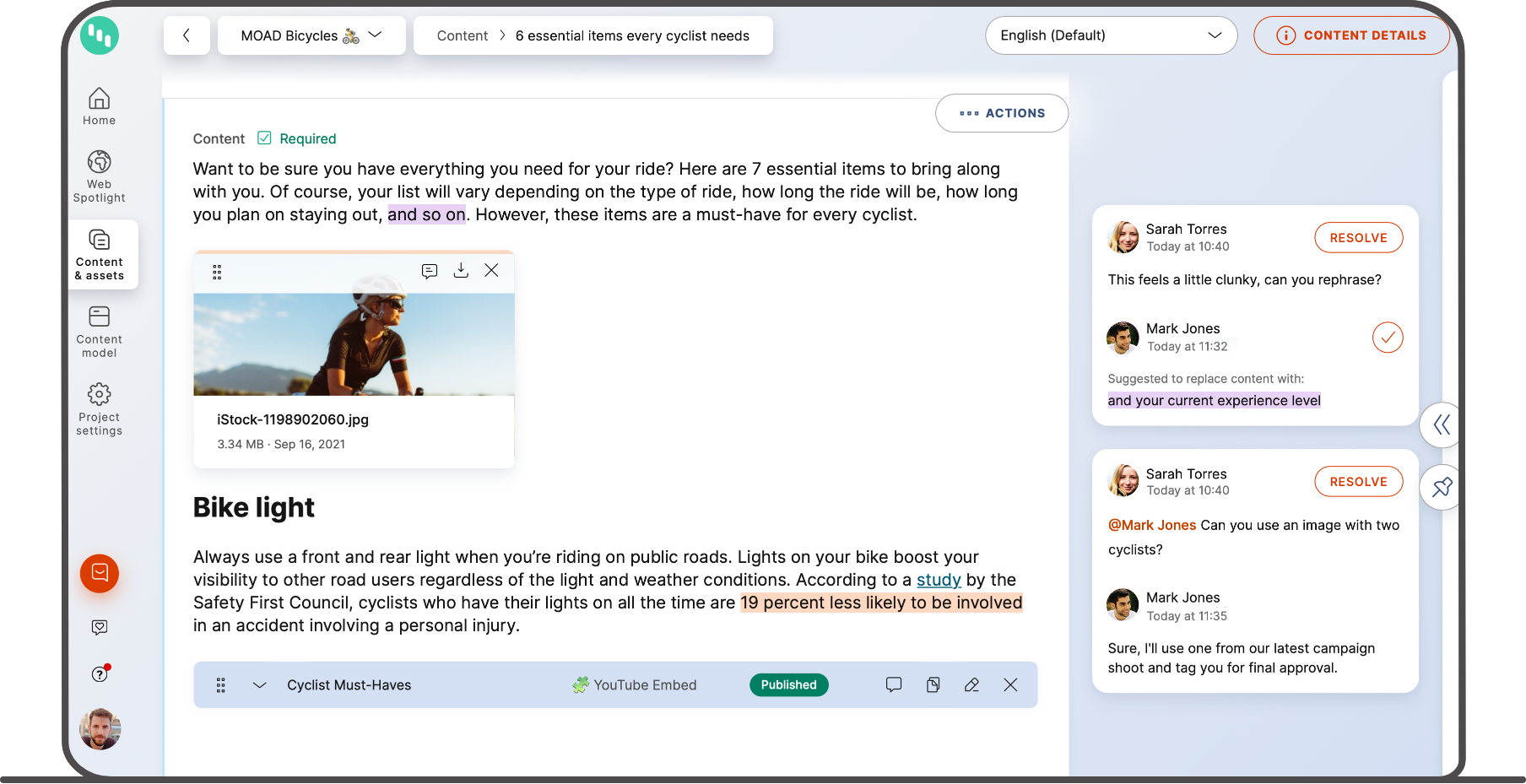
Omnichannel, personalised delivery
Kontent.ai enables brands to distribute content across a multitude of channels, whether that be your website, social media, a chatbot or new channels that will inevitably crop up; content is always future-ready. Create your content once, deliver and reuse. It’s really that simple.
Engage visitors throughout their entire journey by delivering contextually relevant content at the right time by using granular categorisations, global content delivery and flexible integrations. Create tailored messaging to speak to your customers and show that you truly understand them.
Key features
01 Compatible with any technology stack
Content is delivered through structured APIs, which means you can use your chosen technologies to build experiences. This approach also allows you to add, remove or replace services whenever required.
02 Headless approach
Content is created and saved without formatting – allowing it to fit any design you wish. The perfect approach to future-proof your content as channels evolve over time.
03 Cloud-based SaaS
No need to worry about performance issues or system downtime, Kontent.ai is a true cloud service offering a global footprint and high availability.
04 Scalable & Secure
Your data is in safe hands. With enterprise-grade scale and security Kontent.ai can manage projects of any size all whilst keeping your data secure.
The DEPT® approach
By combining Kontent.ai’s technology solutions with DEPT®’s creativity and data, we have the power to help organisations to accelerate.
Our in-house experts have years of experience working with a wide range of technology. Our team can support the technical aspects of implementing a CMS as well as creating digital experiences and setting up organisational processes to ensure your execution of Kontent.ai is a success.
Plus, as a fully integrated digital agency, DEPT® are with you at every step of the process, whether that’s help with branding or SEO, we’re here beyond the deployment of the CMS.
Kontent.ai x ADA/DASH
Kontent.ai is now integrated with ADA/DASH, our website accelerator that provides the building blocks for modern, headless marketing and e-commerce sites. By using best-of-breed tools and frameworks out-of-the-box, less time is wasted on duplicative tasks and more time spent creating an exceptional experience. Explore ADA/DASH.
Questions?
Global SVP Technology & Engineering
Jonathan Whiteside
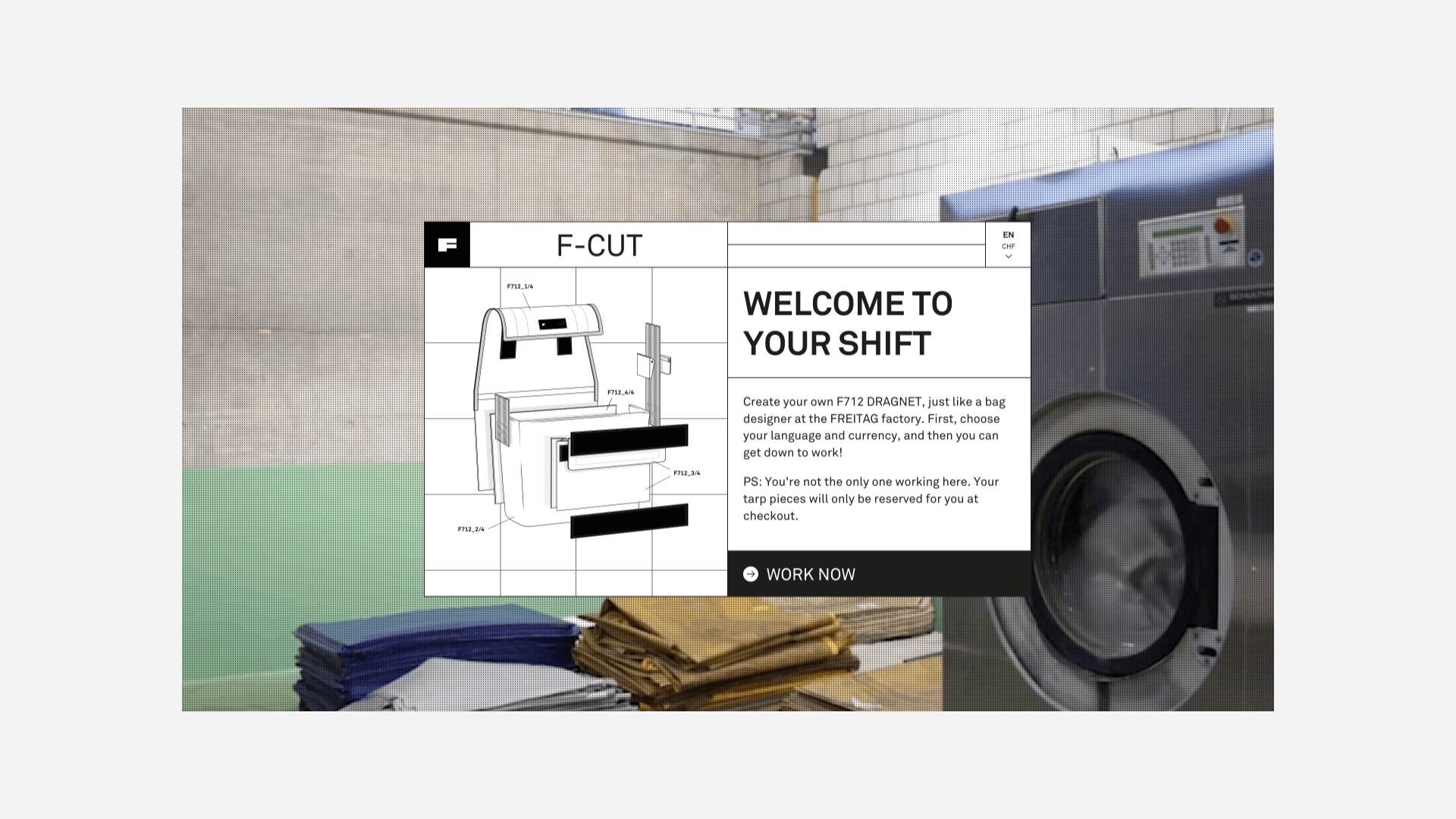
The sustainable Swiss brand FREITAG, known for their bags and accessories made from used truck tarpaulins, has always stood for individualism. With the new digital tool F-Cut, FREITAG now offers its customers the opportunity to design their very own super unique items. The idea behind it was born 20 years ago – and comes from a DEPT® employee.
Desire for more uniqueness
Each of the approximately 300,000 FREITAG bags and accessories produced each year is unique. A large proportion is manufactured in Zurich, where the truck tarpaulins are dismantled and washed by FREITAG employees before the bag designers cut out the best motifs with their cutter knives and templates and these are then processed into bags.
So far, so good. But more and more often, customers inquire in the FREITAG stores whether a specific bag is also available in another color, with this or that motif. The bag makers have taken these requests for (even) more uniqueness to heart – and fell back on the diploma thesis in which DEPT® employee Severin Klaus invented, designed and programmed the first F-Cut for FREITAG 20 years ago.
Democratisation of bag design
The DEPT® team in Switzerland has been working with FREITAG since 2020 and has, among other things, implemented a bag swapping campaign on Tinder for the brand. Now FREITAG approached us to awaken the online cutting table F-Cut from its slumber together with bag and UX designers, logisticians and many other experts.
The following positioning and visions were defined in a preliminary project:
Democratisation of bag design
Every interested customer should have the opportunity to design their own unique bag according to their own taste, beyond all design guidelines.
Bringing FREITAG’s values to life
Sustainability and individualism come first. The FREITAG Sweat-Yourself-Shops are to be transported from the physical to the digital world by means of F-Cut.
Revival of a classic
The new F-Cut is to be as good as the multiple award-winning 20-year-old original, but even more user-friendly and contemporary.
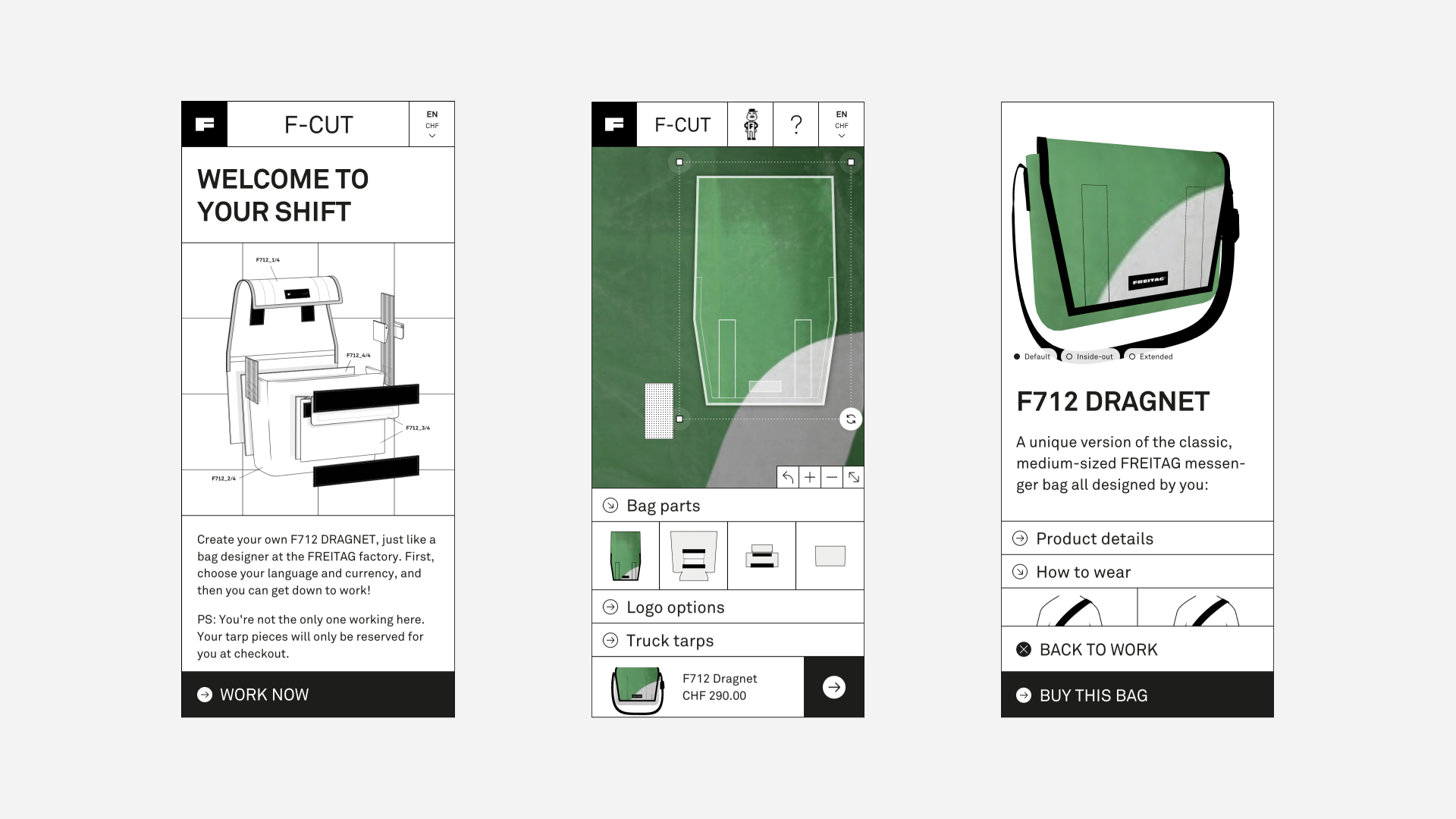
Linking the offline world with the online world
F-Cut offers a unique combination of rough & real materials with digital perfection and a smooth product configuration – no matter on which device, including 3D preview in real time. In this way, the offline world of FREITAG is linked to the online world thanks to a unique experience.
For F-Cut, DEPT® not only implemented the UX, UI and the 3D preview, but also the back- and frontend. The visual identity, creative direction and copy were done by FREITAG.
From a technical perspective, F-Cut is a web application that combines various systems. On the one hand, there is of course the F-Cut app – the GUI – in which FREITAG customers configure their bags. Then there is the F-Cut backend with a headless CMS, which primarily provides a database and communicates via API with the checkout (FREITAG online store) and of course the F-Cut app. In addition, there are further admin interfaces with everyday tarpaulin management functions (configuration, orders, etc.) and tarpaulin upload, editor and export (DXF) for production.
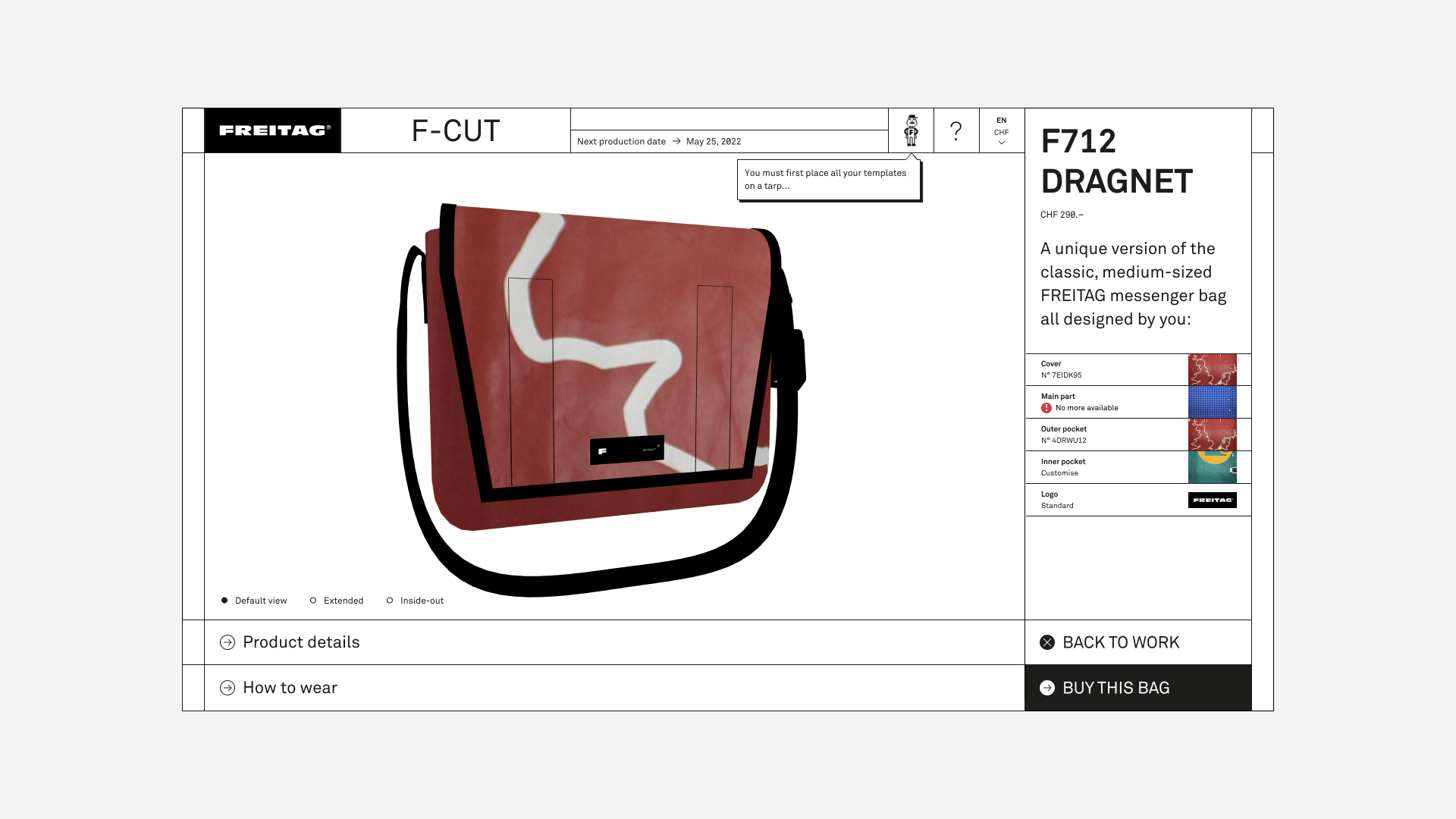
Bag dreams come true
For the first release, the focus was on the KISS principle (Keep It Simple, Stupid): we limited ourselves to one bag type, the Messenger Bag F712 DRAGNET, which can be designed using four virtual templates from a selection of 20-50 different truck tarps. The designable bag types could be expanded in the future or the bag type could change at fixed intervals.
In order to ensure fairness and equality, new tarpaulins are silently added to the system to exclude disputes about the “good” tarpaulin pieces. Another important aspect for FREITAG was the balance between maximum design freedom and sustainability: leftover tarpaulins are used for accessory products.

A few numbers
The response to the F-Cut has been overwhelming, especially from Japan, Germany and FREITAG’s home market Switzerland.
- The virtual cutting table is very busy – between 40-60 users at a time are designing their own F712 DRAGNET Messenger Bag online every day.
- Since the launch in May 2022, more than 300 digitised truck tarpaulins have been used.
- In addition, FREITAG also received many requests from their fans to introduce F-Cut for other bag models as well.
What’s next?
Already before the go-live, F-Cut triggered enthusiasm both among the DEPT® and FREITAG teams. Several further development projects are already planned: more products and features are to follow. 20 years after the birth of the idea, F-Cut has finally awoken from its slumber and will continue to grow steadily.
Over 20 years ago, I got to implement F-Cut as a student one-man show – to rethink this project now, with the support of a fantastic team, both on the DEPT® side and on the customer side, while exploiting the possibilities of today’s technology, is a great privilege.
Severin Klaus, Tech Director, DEPT®
DEPT® LIFE: Technical Architect

Meet Chris, Technical Architect at DEPT®.
10 years in, he’s practically part of the furniture. Here he tells us all about his DEPT® LIFE and why he’s stuck around for a decade.
Name: Chris Eccles
Role: Technical Architect
Time at DEPT®: 10 years
Years in the industry: 12 years
About me: I was a keen rugby player until my ankle gave up. Now have to make do with cycling.
A brief history of me
I studied Computer Science at Cardiff University and after graduating, I started my career in PHP development with an in-house development team.
I joined DEPT® over 10 years ago, starting out as a junior in the Service Delivery Support team, which is now known as Deliver Operation Service (DOS). Since then, I’ve had quite the journey, moving up to Junior Developer (.Net), then gradually to Technical Architect, four promotions later.
Life as a Technical Architect
I work on DEPT®’s client projects all the way through the lifecycle. That means I’ll get involved with the initial workshops help define the client’s requirements, develop technical specifications and proofs of concept to demonstrate how DEPT® can help solve their challenges; as well as architect the final product.
The primary part of my role is to lead the development teams that are delivering projects, supporting both front and back-end developers to resolve any technical blockers as quickly as possible. This could be anything that’s stopping them from completing their work, such as hard to replicate bugs or issues with external services. But I also get to collaborate with the wider team, working with designers to ensure the developers have all the creative assets they need to effectively build, and with QA (quality assurance) to ensure the objectives are met and the output quality meets our standards before delivering projects to clients.
A typical working day
I like to start my day bright and early. I set aside focus time in the morning to get through large documentation. This might include writing technical specifications for projects, writing up findings of a POC or prepping for a client workshop. Then I have a series of short ‘stand up’ meetings to get an update on project progression before cracking on with my own project actions throughout the rest of the day.
Developing POCs is one of the highlights for me. It’s about testing technical methodologies and approaches to give ourselves, and our clients, 100% confidence in how it should be delivered to achieve the best results. For example, I recently investigated ways to use Optimizely as a headless solution and set up visual regression testing to assess its effectiveness for a project.
I tend to work from home most days, so the vast majority of my collaboration and communication with project teams is done via Slack and Google Meet, but it’s great to also have days in the office and catch up with everyone. DEPT®’s flexible working policy suits me really well as I had my second child at the start of the pandemic, and I’m able to maintain a strong work-life balance.
The amazing range of projects and technologies I get to work on is what I love most about working at DEPT®.
Room to grow
As DEPT® is such a large agency, there is so much opportunity to learn from others’ experiences and get a different perspective on matters. The team specialises in so many different disciplines, which is great to have access to. For example, the front-end team have much more experience in React than I do, but it’s great to combine their knowledge with my expertise in back-end systems to deliver optimal, full-stack experiences for clients.
I love that I am constantly working on new technologies and have the time and space to do POC work for innovative new projects coming into the business. Digital technology moves so quickly, and it’s imperative to keep up, which we have the capacity to do at DEPT®.
When I started at DEPT® I had only ever worked in Java and PHP. Now, 10 years on, I’ve worked on CMS technologies like SDL Tridion, Sitecore and Optimizely, amongst multiple others. As well as working with different languages such as .NET, SQL, Razor, React and Angular as well as front end frameworks like Next.JS and Razzle.
I’m thankful to DEPT® for always giving me the opportunity to dedicate time for training and develop new skills, in turn helping me to learn and grow constantly. Also, a big shout out to the amazing colleagues and mentors I’ve had over the years!
Are you ready for the next stage of your career? Explore our open roles today!
More Insights?
View all InsightsQuestions?
Senior Recruiter
Sarah Wilkinson
Microsoft
DEPT® has always had a strong relationship with Microsoft. As .NET experts, we know Microsoft and its services like no other.
Microsoft is constantly evolving
We have a long-term Microsoft Gold Partnership for Application Development and, more recently, added a Gold Partnership for Cloud Platform and DevOps; by expanding our capabilities, we can now provide customers with the full suite of Microsoft services.
We love Azure. Microsoft Azure is a commonly used cloud environment within DEPT® because it fits in well with the technology that we use for our clients. We also have clear agreements with Microsoft about service levels and underlying services, so that we can serve our customers even better. Microsoft’s services have evolved over the past five years, making it even more interesting for us to host our applications and solutions on Microsoft Azure.
Like DEPT®, Microsoft is constantly evolving and improving, and this is reflected in the various Microsoft features we work with. Think of developments such as AI, machine learning, API management, Azure DevOps, Azure WebApps, Cosmos DB, Azure Storage, serverless architectures based on Azure Functions and Logic Apps, and lots more. Other reasons why we use Microsoft Azure include:
Availability
Scaling up to serve regions around the world.
Security
The security services of Azure provides insight into intrusion attempts, vulnerabilities etc.
Governance & Cost Management
By using Azure Lighthouse, we can better monitor and govern our cloud infrastructures and have a good understanding of the costs incurred by the environments.
Our open-source mindset is in line with Microsoft’s strategy. In addition, the available tooling enables us to fully code our infrastructures and Continuous Integration/Continuous Delivery (CI/CD) pipelines.
Our Clients





We value a great working relationship with our clients above all else. It’s why many of them have worked with us for years as their trusted partner.
Approach
Talk to us about Microsoft
Global SVP Technology & Engineering
Jonathan Whiteside
commercetools is a headless e-commerce platform which provides the building blocks for the new, digital commerce age.

A flexible, headless commerce platform
commercetools allows brands to build and enrich their online shopping experience. In order to do so, they provide the speed and flexibility that today’s digital world demands with the use of microservices and APIs. As a commercetools partner, DEPT® is equipped to help companies implement and use this software.
commercetools is a pioneer in the field of microservices. These include all e-commerce functionalities, such as PIM, cart and order management, marketing and promotions, payments and internationalisation. A flexible and fast API connects these services to all relevant front-ends and applications such as webshops, mobile apps, voice, AR/VR applications and social networks. We have implemented this rock-solid e-commerce platform for clients including Eurail, Goudsmit Magnetics and Holland & Barrett.
commercetools operates according to the modern MACH principle: Microservices-based, API-first, Cloud-native and Headless.
Functionality
Microservices
commercetools’ functionalities are developed in a modular way in which each function can be used and developed separately.
API-first principle
More than 300 APIs unlock all kinds of functionalities one could desire. DEPT®-partners Contentful, Bloomreach and Magnolia provide default integrations for commercetools. Due to the ‘API First’ principle, commercetools works efficiently with any front-end solution.
Cloud-Native
commercetools runs entirely in the cloud, guaranteeing IT performance, scalability and security.
Headless
The focus of commercetools is on creating functional commerce building blocks for your webshop.
Compatible with ADA/DASH
commercetools is now integrated with ADA/DASH, our headless e-commerce accelerator that provides the building blocks for modern e-commerce sites. A composable approach impacts both the implementation of the front-end and influences the end-to-end process and methodology, from design through to deployment.
commercetools integrates with DASH and allows for faster development and deployment of your e-commerce store; less time is wasted on duplicative tasks and more time spent creating an exceptional experience.
The out-of-the-box design and development elements provided by DASH include the scaffolding, DevOps and infrastructure, localisation, CMS integration, product search integration, automated testing, performance and accessibility testing, documentation, and monitoring.
ADA/DASH can deliver headless e-commerce sites months faster than traditional development.
Our Clients










We value a great working relationship with our clients above all else. It’s why many of them have worked with us for years as their trusted partner.
Talk to us about commercetools
Principal Digital Consultant, Design & Technology
Katy White
Insights
Crownpeak
The Crownpeak digital experience platform is truly cloud-native – built for providing scalable and secure websites.
A headless de-coupled platform
Integrate with all your existing applications and tools, and deliver trust-building, privacy experiences that are brand consistent and web compliant – on all devices to all users.
Crownpeak Digital Experience Manager (DXM) is an enterprise-level, cloud-native content management system. DXM provides all the multi-site, multi-language, collaboration features you expect, combined with a fast time-to-market and a flexible, headless deployment system. Being cloud-native means DXM is always up to date with the latest features and security and never needs to be upgraded.
Crownpeak takes its headless core and layers additional capabilities designed for enterprises on top to help you maximise effectiveness across your digital presence. Model your content needs, create content assets from those models, populate content into your assets using any number of WYSIWYG layouts to make sure content fits and looks great, and distribute that content. Optionally, you can even decide which pieces of content get delivered and when, across any device.
Privacy UX is a new way to approach privacy. By incorporating customer experience best practices and human-centered design into the privacy experience, you can meet customer expectations, build trust, and strengthen customer lifetime all while remaining compliant with global privacy laws.
Crownpeak is an excellent choice for compliance-conscious businesses. Create consent experiences for your website that comply with the consent requirements of the GDPR, CCPA, and other global privacy laws through a single unified platform. With flexible controls, you can leverage consent APIs and create optimised consent experiences that build trust with your audience and fit seamlessly into your overall web and customer experience.
Crownpeak’s content delivery services have been engineered for speed, scalability, resiliency, and availability. It leverages Amazon’s Content Distribution Network (CDN) technologies (CloudFront) to ensure your audience gets rapid experiences no matter where they are in the world.
The DEPT® way
At DEPT®, we combine creativity and data with technological solutions such as Crownpeak to help organisations grow and accelerate. Below are five reasons why DEPT® is the ideal partner to get the most out of Crownpeak:
Crownpeak Professional Partner
Our developers are certified on Crownpeak technology and optimally equipped to create great digital experiences.
Experienced and successful
We have been working successfully with a wide range of technology leaders for many years. With our experience in diverse sectors, we help a wide range of customers to embrace digital.
Full approach
Digital growth does not stop with the successful deployment of Crownpeak. As a fully integrated digital agency, we also support SEO, creative campaigns, e-commerce, strategy and organisation, branding, data intelligence and more to help your organisation grow and develop.
Widely deployable
Our teams have broad experience in both the technical aspects of a CMS as well as in setting up the organisational processes to use Crownpeak successfully. Besides projects, we can also temporarily strengthen an existing team with our specialists.
In-house experts
Our years of expertise in designing experiences, expandable architecture and integration of technology is not something we want to keep to ourselves. We share our knowledge as Crownpeak experts in our in-depth blogs in which we tackle practical challenges
Talk to us about Crownpeak
Technology Consultant
Phil Robinson
Contentful
Contentful is a modern cloud-native content management system that is ready for the future like no other.
700
Developers
10
Countries
Accelerate your digital business with Contentful
Contentful gives its users the tools they need to create and manage their content. Thanks to its headless architecture, developers can use this tool with any programming language, on any platform. As a certified Contentful partner, DEPT® is equipped to help companies implement and use this tool.
The modern digital landscape requires brands to have much more than a simple website. Companies want to offer their customers a uniform, personalised omni-channel experience with websites, apps, chatbots and marketplaces. Contentful offers its customers a user-friendly ‘unified content hub’ for content management across all channels. Developers can also use this tool because it has a powerful API which can be used on any channel, with any programming language. Contentful is also ideally suited to add content management capabilities to existing digital applications, where content changes now need to be made by developers.
As a SaaS, Contentful is built directly in the cloud and therefore also takes advantage of the associated benefits such as scalability, availability and speed. It also eliminates expensive upgrades.
Contentful has the following features which distinguish it as a modern CMS:
- API first: Since API’s are at the core of this system, all content can be accessed via the API’s
- Cloud-native: Contentful is built in the cloud, which makes the system infinitely scalable and uses cloud services as a standard CDN.
- SaaS solution: Every Contentful customer uses the same system (just like Gmail, Dropbox, Netflix, Uber or Facebook, for example), so no management is required and upgrades are a thing of the past.
- Freedom for developers: The APIs of Contentful can be used with any programming language. For fast onboarding SDK’s are available for Javascript, .Net, PHP, Java, Android, IOS, Ruby and more. A matter of ready, set, code.
- Headless/decoupled: The world is changing, we are moving away from monolithic systems and headless is the answer. With headless and best-in-class documentation, Contentful can support even the most complex digital ecosystems.
Our clients








We value a great working relationship with our clients. It’s why many of them have worked with us for years as their trusted partner.
Our approach
At DEPT®, we combine creativity and data with technological solutions such as Contentful to help organisations grow and accelerate. Below are five reasons why DEPT® is the ideal partner to get the most out of Contentful:
- Contentful professional partner: Our developers are certified on Contentful technology and optimally equipped to create great digital experiences.
- Experienced and successful: We have been working successfully with a wide range of technology leaders for many years. With our experience in diverse sectors, we help a wide range of customers to embrace digital.
- Full approach: Digital growth does not stop with the successful deployment of Contentful. As a fully integrated digital agency, we also support SEO, creative campaigns, e-commerce, strategy and organisation, branding, data intelligence and more to help your organization grow and develop.
- Widely deployable: Our teams have broad experience in both the technical aspects of a CMS as well as in setting up the organizational processes to use Contentful successfully. Besides projects, we can also temporarily strengthen an existing team with our specialists.
- In-house experts: Our years of expertise in designing experiences, expandable architecture and integration of technology is not something we want to keep to ourselves. We share our knowledge as Contentful experts in our in-depth blogs in which we tackle practical challenges
Talk to us about Contentful
Global SVP Technology & Engineering
Jonathan Whiteside
Whether you’re coming at consumer-facing commerce as a fresh face or are well versed in the sector, researching the available platforms is vital in making an informed decision about which platform is right for your business. For any company looking to understand more about the commerce platform market, the Forrester Wave reports are an invaluable resource. The Forrester Wave™: B2C Commerce Suites, Q2 2020 evaluates each platform across thirty-one criteria to assess the strengths and weaknesses of each available platform and analyses the trends developing in the industry at large.
This is particularly important as there is no single ‘must-have’ platform. The commerce platform sector has plenty of entrants and sees constant innovation, creating a marketplace that is both highly specialised and broad. Because of this, businesses must take a tech agnostic approach and review each of the available options when considering a new B2C platform. This makes it possible to match the various benefits of each vendor with your business’s key needs and aims, rather than choosing a market leader from the outset and trying to fit a square peg in a round hole. To begin the process, here are a few important points and questions to consider.
3 key considerations
Early on in the process of choosing a vendor, it’s important to consider three types of ease:
- How easy is it to integrate the platform into your existing tech stack?
- How easy is the platform to use?
- How easy is the platform to update/upgrade?
These three factors are at the core of your experience of the platform. Any complications in these areas and the business may not be able to maximise its investment in the selected solution.
Aware of the difficulties of integration, there’s been a trend in the industry towards out-the-box B2C commerce platforms, offering sellers a simple route to market with the added benefit of architecture that has been proven to work by other online stores. For companies with a more complex offering, or those looking to make use of a wide array of additional features, finding out more about the integration of each add-on and custom feature is a must. The right platform should fit your digital roadmap, catering to your current needs and future aims.
Easy of use
When considering the ease of use, there are two areas to focus on. The first is external – what kind of educational and instructional material does the vendor provide? This could come in the form of knowledge-share resources, 24/7 online support, or scheduled training sessions. This offering varies, and each business will have a different preference for how educational and instructional information is provided. Equally, if a commerce platform requires extensive training to get up-to-speed, it may not be the right fit. If the priority is getting a B2C platform up and running quickly, the time it takes to learn how the service works is an important factor to consider.
When considering ease of use, think of how various processes can be managed through one platform, rather than a series of siloed solutions. For a diversified tech stack, this means building a unified user interface, where possible, to prevent hopping between interfaces.
The second is internal – how does the platform fit with the expertise of your in-house development teams? Colleagues may already have experience with a certain platform, which is a useful benefit, particularly for vendors that provide more customisation options. Whether the platform solves the business’s aims is the top priority, but prior experience can be a tie-breaker factor when choosing a platform.
Updates & upgrades
Businesses that are new to commerce platforms can often overlook the update and upgrade process. Some updates can cause downtime, something that no e-commerce site wants. Additionally, upgrades and updates can be costly and slow down the adoption of new features, requiring a complete platform update to use a new feature.
In the past, tech providers offered annual and quarterly updates to the service, however, this is changing as each vendor looks to keep up with the speed of innovation in the sector and provide regular updates.
While the sector is trending towards continuous deployment and no downtime models, be sure to speak to vendors about their update and upgrade process to ensure that the e-commerce site will be able to avoid downtime wherever possible, and stay up-to-date with the latest developments in e-commerce.
B2C commerce suites
When selecting a platform, it’s always important to choose the right option for your business’s needs, not just the market-leading option. Features differ, specialisation differs, the design differs. Below, we have assembled DEPT®’s collected thinking and a number of case studies to provide more of an understanding of a selected number of platforms to consider when looking for an e-commerce service.
Salesforce Commerce Cloud
Salesforce’s strength lies in personalisation and AI-powered decision making. Building an e-commerce site is simple through the Page Designer tool, a feature of Salesforce Commerce Cloud that makes it easy for marketing departments to create content pages in a user-friendly environment. Page Designer’s ease of use makes it an ideal feature for companies looking to frequently create new product pages and in-house the building of new pages, following the initial implementation. Saving time this way is a major benefit for companies that want to be up and running as soon as possible.
Working with Bugaboo and using Salesforce Commerce Cloud, DEPT® built and launched the pushchair brand’s new site in 26 countries in just four months. The initial build is the first step, with potential in the future to improve the shopper experience with 3D product models on each page and the ability to share custom products.

Episerver commerce cloud
In the B2C commerce market, Episerver stands out as a digital experience-focused offering for mid to large-sized enterprises. Plenty of personalisation features facilitate relevant shopping experiences for each shopper, and the level of custom configuration make it a popular platform for many developers.
There are plenty of API possibilities through Episerver, including the use of headless commerce, putting Episerver users in a strong position for the future of e-commerce and making the expansion of e-commerce options to new services, like voice assistants and smart wearables, a much simpler task.
Commercetools
commercetools pride themselves on their API first principle; more than 300 available APIs unlock hundreds of different functions for businesses to consider, across websites, social media, mobile apps, VR/AR experiences and voice assistants. This naturally builds into a headless approach.
The commercetools approach centres squarely on e-commerce activation, making it a useful fit for companies that are already happily settled with their current CMS system, as shown in DEPT®’s work with Eurail.com. This project integrated Adobe Experience Manager and commercetools to fast track the success of the train ticket site through an out of the box solution.
Shopify
Shopify stands out from the market by targeting small to midsize independent retailers, rather than large enterprises. Shopify’s platform is focused on growth, opening doors for retailers with a limited number of stores to grow online. This is supported by the recently launched Shop app, a marketplace for all stores that use Shopify as a commerce platform, boosting discovery.
The Shopify Plus option provides deeper levels of automation through a number of add-on applications, as well as headless commerce. AR product pages are also an option, allowing smaller businesses to create a shopping experience that rivals the major players in their industry.
Getting started
There is a broad spectrum of platforms to consider, the above examples are just a small cross-section of the various available suites. Manoeuvring through this market requires a clear view of what your business needs and a deeper understanding of how each option fits (and doesn’t fit) the key aims of the company.
Do your own research, read recent reports and material published by each platform, and start conversations with platform vendors and possible partners. This is an evolving process; it can take time to become conversant with the market, but it begins with the first step. If you need any advice, DEPT®’s commerce technology experts would be happy to help you.
More Insights?
View all InsightsQuestions?
Global SVP Technology & Engineering














